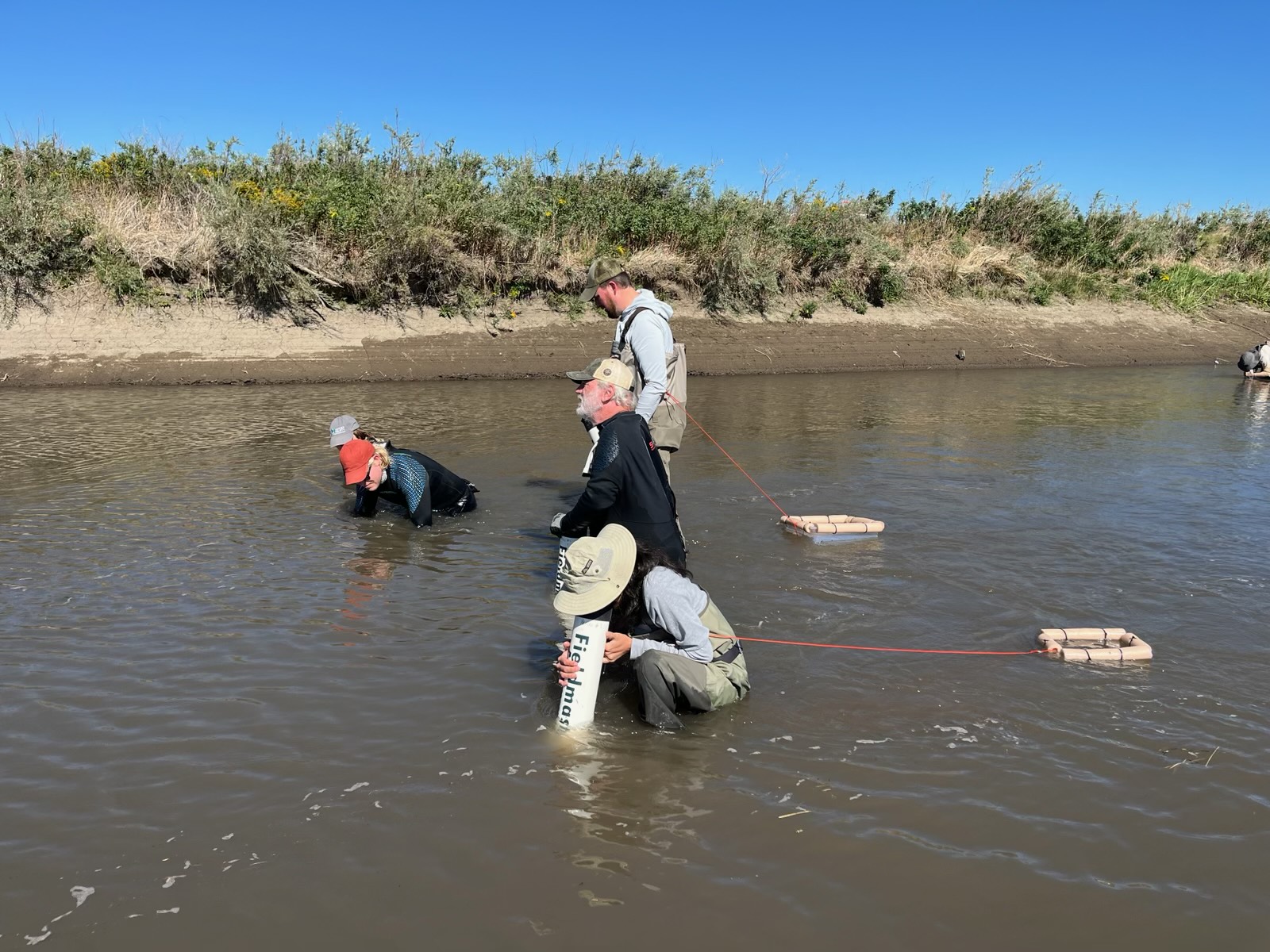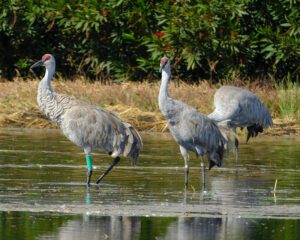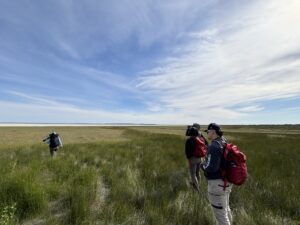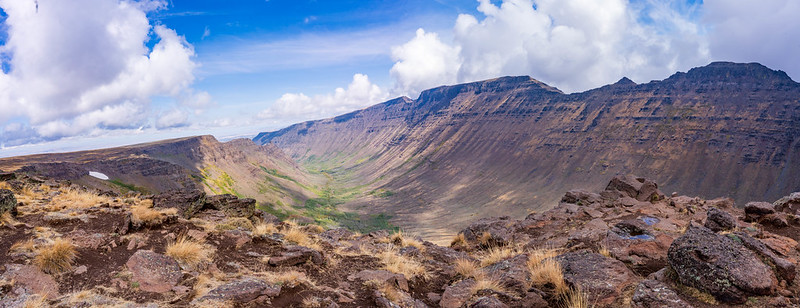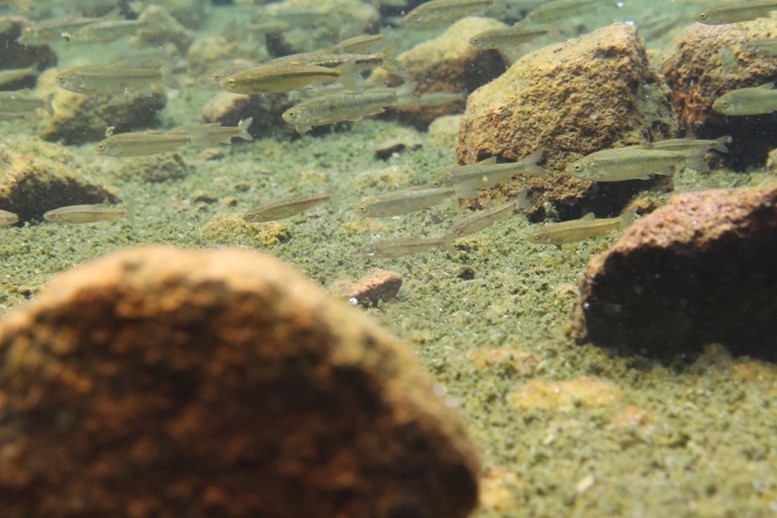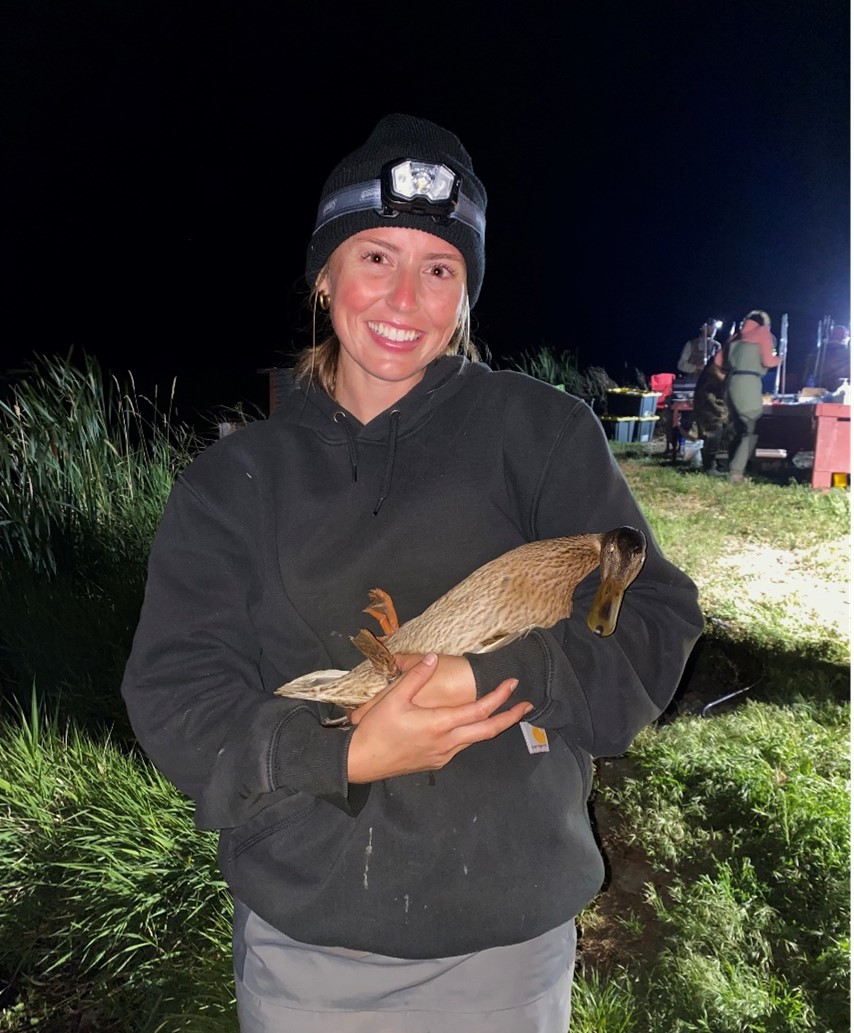Photo of western ridge mussel response crew searching for and removing mussels.
Written by Craig Walker/Photos by Dominic Bachman
Back in June I was sitting at home with no real plans for the summer when I saw in the FOMR newsletter that they needed a volunteer for the Crane’s Nest store for the month of July. Next thing I knew I was staffing the store on weekends and having such a good time I asked if I could stay through August. As it turned out there was a bat survey in the works in August and a mussel salvage project also happening that month. As a retired bat and mussel biologist for the Department of Interior, these two projects couldn’t have been more suited to my skills and interest.
 Of course, Mother Nature had a thing or two to say about how the summer would go. There was a period of time when the temperature got up over 100 degrees several days in a row. We found several dead bats around headquarters, apparently killed by the heat. The famous Malheur mosquitos weren’t quite as bad as advertised, however. Also, I totaled my car on a remote back road I shouldn’t have been on and had to be rescued, but that’s another story.
Of course, Mother Nature had a thing or two to say about how the summer would go. There was a period of time when the temperature got up over 100 degrees several days in a row. We found several dead bats around headquarters, apparently killed by the heat. The famous Malheur mosquitos weren’t quite as bad as advertised, however. Also, I totaled my car on a remote back road I shouldn’t have been on and had to be rescued, but that’s another story.
And then there were the fires. Two very large wildfires, the Falls Fire and the Telephone Fire, burned most of July and August north of Burns, at times threatening the town. Although they were at least 30 miles or more from headquarters, their smoke caused air quality at the refuge to be less than ideal much of the summer.
The Bat Survey
The headquarters complex at Malheur NWR has several buildings constructed of native stone by the Civilian Conservation Corps (CCC) in the 1930s. These buildings are historically significant cultural resources that are now are used by refuge staff as offices and/or residences, and one serves as a visitor center and headquarters building. Another is a barn which serves as storage for stewardship equipment and materials for the Friends of Malheur.
All of the CCC buildings in the headquarters complex are also occupied by bats. They are roosting underneath the roof tiles and in the attics of these buildings. Evidence of bats in the form of feces is abundant in the complex. Small piles of guano can be seen on the ground as can individual fecal pellets stuck to the sides of the stone buildings, probably as a result of night roosting. Bats will rest between foraging bouts and/or prior to reentering the buildings to roost. It is likely these buildings are used as maternity colonies in which females give birth and nurse their young until the young are able to fly. It’s difficult to know for sure without trapping the bats and checking for bone development, sex, and lactation status.
The purpose of this project was to collect data on the diversity and abundance of bats occupying the headquarters complex building. There is a long range plan to reseal the roofs of the headquarters buildings to permanently exclude bats. This is necessary to reduce the risk to human health caused by the accumulation of guano around the complex in addition to preserving the integrity of the aging buildings. Information on the bat population in the complex is needed to plan for replacement of roosting habitat that will be lost when bats are excluded from the buildings.
We collected data on the bats around the headquarters complex in 2 ways. We counted them by watching them exit the buildings around dusk each evening of the survey. We also used an acoustic detector called an EchoMeter Touch 2 that can “hear” the ultrasonic calls bats make when they’re flying. It is a small device that plugs into a smart phone or tablet and records the bats’ calls as they fly by. It slows down the ultrasound, which is above the range of human hearing, so that we can hear it and it also provides a visual representation of the call, since bat calls are species specific. It also automatically identifies the species making the calls for you. It is a great inexpensive citizen science device.
The recordings can be further analyzed with software to more accurately identify the species recorded. We’re planning this further analysis to refine the identifications so as to better plan for the replacement of habitat that will be lost when the buildings’ roofs are remodeled.
We conducted the survey for 3 nights in early August. We recorded 14 species and counted 783 bats exiting the buildings in the headquarters complex. We got more Little brown bat calls than any other species, followed by California bat and Yuma bat. The other species whose calls we recorded were: Western small-footed bat, Long-legged bat, Silver-haired bat, Hoary bat, Mexican Free-tailed bat, Big Brown Bat, Pallid bat, Townsend’s Big-Eared bat, Fringed bat, Canyon bat and Long-eared bat.
Thanks to volunteers Randy and Sandy Reed, Bob Luce, Michael Imel, Mickey Weaver, Linda Craig, Jennifer Devlin, Al Huntley, Sarah Kessler, Emilee Gooch, and Roger, Shani, and Ollie Hodge. Special thanks to Bonnie Hall for help with organizing the acoustic files. The project wouldn’t have been possible without all our wonderful volunteers.
The Mussel Rescue
Dunn Dam on the Blitzen River in the refuge was an aging structure that was a maintenance headache for refuge staff. Plans to remove it have been in the works for years and finally came to fruition in August. It was a big operation that involved a lot of work in the river, including diverting water around the dam so that replacement structures could be constructed.
Drying up this reach of the river meant that the freshwater mussel species living there, the western ridged mussel, would have to be rescued and moved to safety in another reach of the river. The western ridged mussel, while locally abundant in the Blitzen, is in trouble range wide and is under review by the Fish and Wildlife Service for listing under the Endangered Species Act.
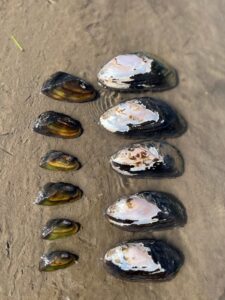 Freshwater mussels are fascinating animals that not only provide ecosystem services in the form of water filtration but have a complex lifecycle that requires their larvae to attach to a fish host in order to transform into juvenile mussels.
Freshwater mussels are fascinating animals that not only provide ecosystem services in the form of water filtration but have a complex lifecycle that requires their larvae to attach to a fish host in order to transform into juvenile mussels.
The rescue operation took almost 2 weeks and involved a host of people. In addition to myself, refuge biologists Alexa Martinez and Dominic Bachman and irrigation technician Sarah, we had crew from The High Desert Partnership in Hines, The Xerces Society for Invertebrate Conservation, Oregon Department of Fish and Wildlife, and several other organizations.
Initially we used viewing scopes to spot mussels with their siphons out filtering water, then gently digging them out by hand. Mussels anchor themselves in the substrate pretty firmly and can be difficult to dislodge. However, it’s important to be gentle when pulling them up since their tissues can be damaged by rough handling.
Once the dam removal and diversion got further along the water became too turbid to use the viewing scopes. We then had to crawl around in the mud feeling for mussels with our hands. The water in the river was a bit cold and we had people wearing a variety of exposure protection, everything from waders to wetsuits to dry suits. It was muddy, strenuous work.
As we collected the mussels, we put them in floating baskets until we had enough to move. We then put them in coolers and drove them to their new homes upriver. We planted them by hand at several sites in the Blitzen where there were already healthy mussel communities. We moved close to 8,000 mussels over the course of the project.
All in all, it was a great summer. I look forward to coming back next year and helping out the refuge and the Friends.

